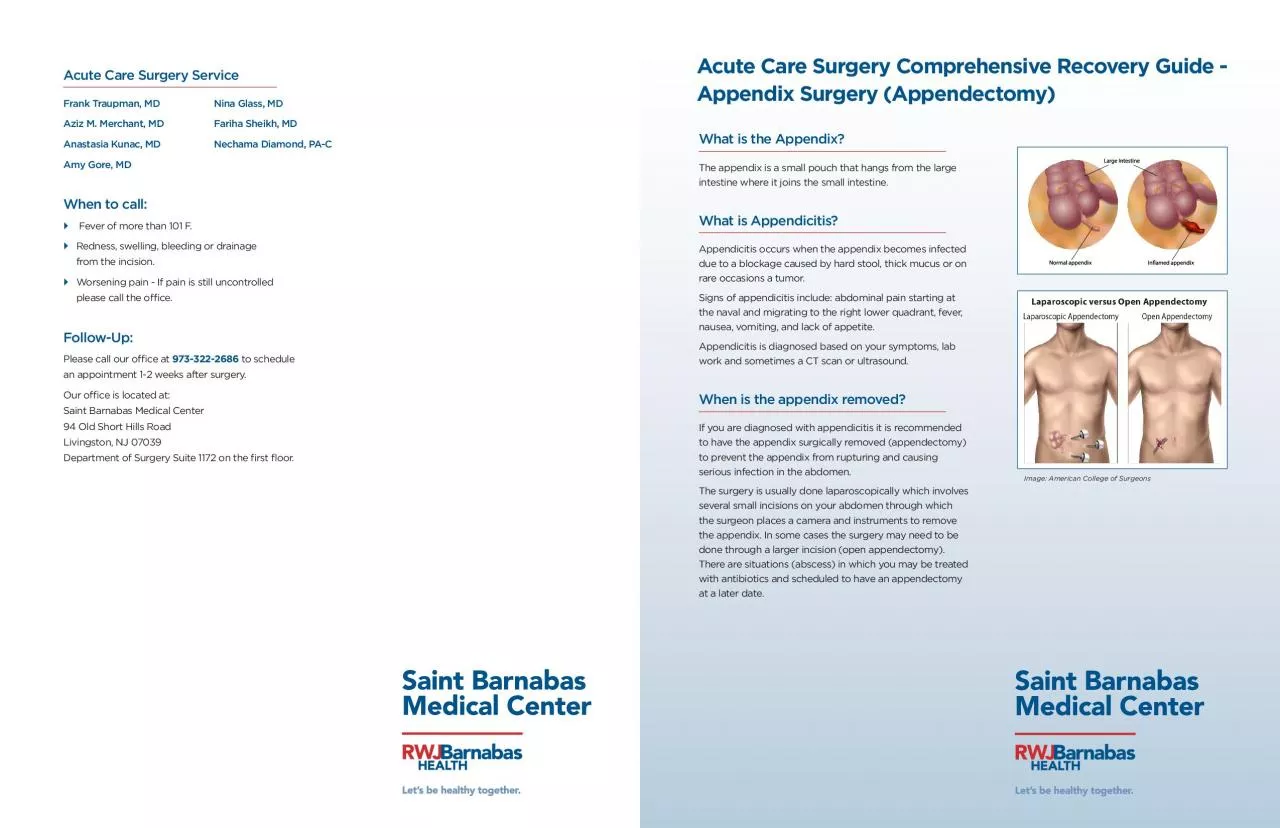

Appendix Surgery Appendectomy Acute Care Surgery Service Frank Traupman MD Nina Glass MD Aziz M Merchant MD Fariha Sheikh MD Anastasia Kunac MD Necha ID: 936269
Download Pdf The PPT/PDF document "Acute Care Surgery Comprehensive Recover..." is the property of its rightful owner. Permission is granted to download and print the materials on this web site for personal, non-commercial use only, and to display it on your personal computer provided you do not modify the materials and that you retain all copyright notices contained in the materials. By downloading content from our website, you accept the terms of this agreement.
Acute Care Surgery Comprehensive Recovery Guide - Appendix Surgery (Appendectomy) Acute Care Surgery Service ______________________________________ Frank Traupman, MD Nina Glass, MD Aziz M. Merchant, MD Fariha Sheikh, MD Anastasia Kunac, MD Nechama Diamond, PA-C Amy Gore, MD When to call: Fever of more than 101 F. Redness, swelling, bleeding or drainage from the incision. Worsening pain - If pain is still uncontrolled please call the o ce. Follow-Up: Please call our o ce at 973-322-2686 to schedule an appointment 1-2 weeks after surgery. Our o ce is located at: Saint Barnabas Medical Center 94 Old Short Hills Road Livingston, NJ 07039 Department of Surgery Suite 1172 on the rst oor. What is the Appendix? ____________________________________________ The appendix is a small pouch that hangs from the large intestine where it joins the small intestine. What is Appendicitis? ____________________________________________ Appendicitis occurs when the appendix becomes infected due to a blockage caused by hard stool, thick mucus or on rare occasions a tumor. Signs of appendicitis include: abdominal pain starting at the naval and migrating to the right lower quadrant, fever, nausea, vomiting, and lack of appetite. Appendicitis is diagnosed based on your symptoms, lab work and sometimes a CT scan or ultrasound. When is the appendix removed? ____________________________________________ If you are diagnosed with appendicitis it is recommended to have the appendix surgically removed (appendectomy) to prevent the appendix from rupturing and causing serious infection in the abdomen. The surgery is usually done laparoscopically which involves several small incisions on your abdomen through which the surgeon places a camera and instruments to remove the appendix. In some cases the surgery may need to be done through a larger incision (open appendectomy). There are situations (abscess) in which you may be treated with antibiotics and scheduled to have an appendectomy at a later date. Image: American College of Surgeons Time in hospital Once Discharged Pain Management • IV and oral medications • TAP Block (done by anesthesia) Acetaminophen (Tylenol®) and Ibuprofen (Motrin®, Advil®). Alternate taking Acetaminophen and Ibuprofen every 4-6 hours on a regular schedule for the rst 1-3 days. Then take as needed. Do not take more than 4,000mg of Acetaminophen per day or 3,200mg of Ibuprofen per day. He
at or ice packs. Do not place the pack directly on your incision, place a towel or clothing between the pack and your skin. • If you need to cough, place a pillow over your abdomen for support. Pain after surgery is expected and normal. The pain is typically worse the rst 1-3 days and will improve every day thereafter. Shoulder pain can occur after laparoscopic surgery. Nutrition Drink carbohydrate loading drink 2 hours before surgery Post-op: Regular diet unless nausea/vomiting or if doctor indicates di erently • Regular diet – high- ber foods • Stay hydrated Activity • Out of bed 2 – 4 hours a day • Ambulate at least 3 times a day in hallway • Walk as much as possible, this will help with gas pain. • Do not lift more than 10-15 pounds for the rst 4-6 weeks after surgery. • Slowly work up to 30 minutes of moderate-intensity physical activity most days of the week. • Do not drive if you are taking opiate pain medication. Medications • IV antibiotics • IV and oral uids • Pain Medications • Stool Softeners Medications reconciliation/cross-checked and reviewed before discharge: • Stool softeners (Miralax®, docusate) • Simethicone (Gas-X®) as needed Respiratory Incentive Spirometer 10 breaths each hour when awake • Incentive Spirometer 10 breaths each hour when awake Skin You may shower next day after your surgery If you have surgical glue (Dermabond) covering the incisions it will peel o on its own around 2 weeks after surgery. If you have gauze and tape (Tegaderm) covering your incisions please remove this 1-2 days after surgery. Keeping these dressings on too long can lead to infection. Under the gauze will be small tape strips (Steri-strips) these will peel o on their own, do not remove them. • Do not pick at surgical tape or glue. The steri-strips or dermabond can get wet. Do not scrub the incisions, let soap and water run over your abdomen. • Do not soak in a tub or pool until you’re instructed. Testing • Routine Blood work • Pre-op Imaging (CT or ultrasound) • Chest X-ray • EKG if needed • Repeat imaging or bloodwork as per doctor’s orders. Planning for Home Discharge planning • Schedule follow-up appointment with surgeon 1-2 weeks after surgery. • Prescriptions for new or changed medications should be lled and reviewed with patient and family